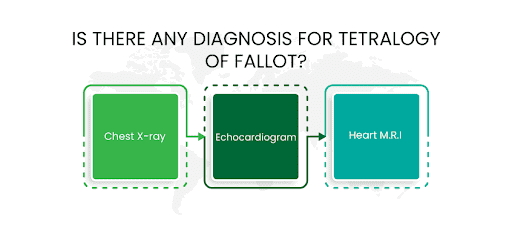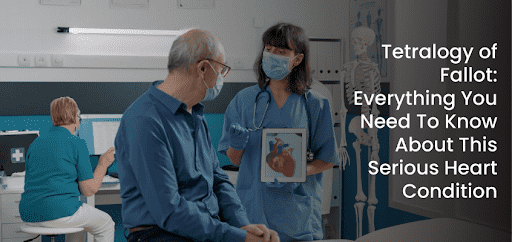Introduction
The tetralogy of Fallot is a combination of four defects in the heart. It is a rare congenital heart defect, which means that it is present at birth and results from structural abnormalities in the heart of the developing embryo. It causes poor oxygenation of the blood. Therefore, children with the Tetralogy of Fallot have a bluish hue to their skin. Let us learn more about the causes, symptoms, and treatment of this serious heart condition.
Our Wellness Programs
What is a heart?
The heart is a fist-sized muscular organ located behind and slightly left of the breastbone in humans. The heart is a vital organ without which we cannot survive. It is a delicate organ, and the rib cage protects it.
The heart is responsible for pumping blood throughout our body with the help of blood vessels known as arteries and veins and the cardiovascular system.
Functions performed by the Heart.
Following are the main functions performed by the heart:
- · Pumping oxygenated (pure) blood to all the body parts.
- · Collecting deoxygenated (impure) blood from other body parts and sending it to the lungs for oxygenation (purification).
- · Maintaining the blood pressure of our body.
Looking for services related to this subject? Get in touch with these experts today!!
Experts

Banani Das Dhar

India
Wellness Expert
Experience: 7 years

Devika Gupta

India
Wellness Expert
Experience: 4 years

Trupti Rakesh valotia

India
Wellness Expert
Experience: 3 years

Sarvjeet Kumar Yadav

India
Wellness Expert
Experience: 15 years

Shubham Baliyan

India
Wellness Expert
Experience: 2 years

Neeru Dahiya

India
Wellness Expert
Experience: 12 years
The tetralogy of Fallot in a newborn is a big concern.
All the body parts receive oxygen and nutrients through blood pumped by the heart. Hence, improper functioning of the heart can result in less oxygen supply to the whole body and is a big concern. The newborn baby often needs surgery as soon as possible. Therefore, this congenital disability is considered critical.
Tetralogy of Fallot results from the following four structural defects in the heart and major blood vessels:
- Formation of a hole between the right and left ventricles (ventricular septal defect).
- Constriction of the pulmonary valve and the main pulmonary artery results in pulmonary stenosis, which obstructs blood drainage from the heart to the lungs for oxygenation.
- Disorientation of the aorta, such that it lies over the right ventricle and ventricular septal defect, instead of the left ventricle, as in the normal heart. It results in the mixing of oxygenated and deoxygenated blood.
- Excess thickening of the right ventricle walls is also known as ventricular hypertrophy because the heart has to overwork to pump blood.
What are Signs and Symptoms of Tetralogy of Fallot
Symptoms of Tetralogy of Fallot may vary depending upon the severity of blood obstruction. Common signs and symptoms are as follows:
- Bluish skin colouration is due to low blood oxygen levels, also known as cyanosis.
- Shortness of breath.
- Difficulty feeding.
- Low stamina, getting tired quickly.
- Cardiac murmur.
- Increasing crying and irritability
- Clubbing of fingers and toes.
- Fainting spells.
- Delayed development and poor weight gain
Babies suffering from Tetralogy of Fallot may sometimes suddenly develop deep blue colouration of the skin, lips, and nails after prolonged episodes of crying. These are known as tet spells and are more commonly seen in 2-4 months infants.
Seek immediate medical attention if your baby turns blue. In the meantime, place the baby on its side and bend the knees of the baby towards its chest. It will improve the blood flow to the lungs and relieve the condition.

Is there any diagnosis for Tetralogy of Fallot?
The doctor diagnoses Tetralogy of Fallot in the womb if the fetal ultrasound displays some abnormalities. It can also be diagnosed at birth if the baby has a heart murmur or the baby’s skin is bluish. Tetralogy of Fallot mostly gets diagnosed during infancy, but sometimes the diagnosis can be delayed if the severity is low and the symptoms are not very apparent.
Some of the diagnostic tests which help in establishing the diagnosis of Tetralogy of Fallot are:
- Chest X-ray to detect structural abnormalities
- Echocardiogram for diagnosis of heart murmurs and dysrhythmias.
- Pulse oximetry to measure the levels of oxygen in the blood.
- Heart M.R.I. to look for structural abnormalities of the heart.
- Cardiac catheterisation to assess the heart’s structure and degree of stenosis and plan the surgery accordingly.
Is there any feasible treatment for the Tetralogy of Fallot?
Surgery is the only possible treatment for Tetralogy of Fallot because it is a structural abnormality that needs to be repaired. Doctors usually perform surgery within the first year of a baby’s life. Surgery for Tetralogy of Fallot is open-heart surgery and involves the following:
- Closing the ventricular septal defect (V.S.D.) with a patch.
- Enlarging or replacing the constricted pulmonary valve by increasing the blood flow.
With increased blood flow, the cardiac workload decreases, and the thickening of the right ventricle resolves gradually over a few months.
If the baby is born premature or the pulmonary artery is still undeveloped, doctors might deem it unsafe to perform open-heart surgery. In such cases, a minimally invasive procedure is performed to place a shunt between a branch of the aorta and pulmonary artery to increase the blood supply to the lungs. Open-heart surgery is completed once the baby becomes healthier and removes the shunt.
If left untreated, this heart defect can result in developmental delays and interfere with the child’s regular breathing, eating, playing, and other activities.
Conclusion
Tetralogy of Fallot is a rare condition that can be critical and quite disabling, which requires prompt treatment and surgical intervention. The causes of the Tetralogy of Fallot are not clear, but it is linked to alcoholism in the mother, advance-age pregnancy, poor prenatal nutrition, and diabetes in the mother.
People with Tetralogy of Fallot might require some activity and exercise restrictions and need to have regular follow-ups with their physicians for the rest of their life. Regular examinations will help detect any cardiac or other problems at early stages and result in timely treatments.
People with Tetralogy of Fallot may require some medications even after surgery. It is essential to inform the physician if they start any new medicine for other diseases to prevent drug interactions. They can lead an everyday life with some activity modifications and regular follow-ups.
For more informative, health-related articles, visit test.unitedwecare.com.















